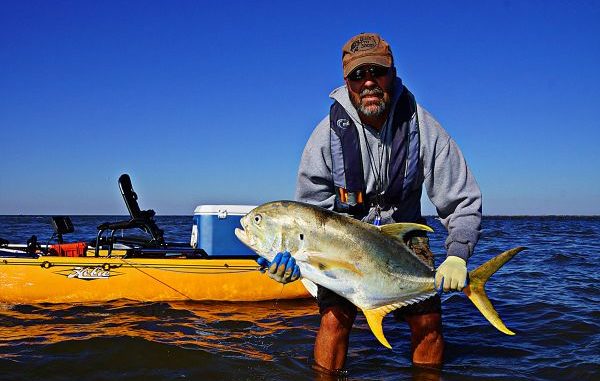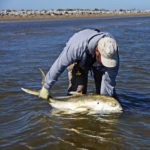
Chasing jack crevalle from a kayak is fun fishing
The predominant fish sought by coastal kayak anglers are no doubt trout and redfish. However, the most hard-hitting and pound-for-pound all-out fighting machine is the jack crevalle.
Catching a bull redfish is often referred to as a “Cajun sleigh ride,” but catching a jack is like playing tug-of-war with a tank.
Jacks are not regularly sought after, primarily due to the fact that they make terrible table fare. A lot of fishermen live by the “if I can’t eat it, I don’t want to catch it” rule.
The flesh of a jack crevalle is the color of red velvet cake and tough, and — though many have tried — there really is no preparation method or recipe that makes it sufficiently palatable.
However, lack of dinner aside, catching a jack from a kayak is an awesome experience, and one you won’t soon forget.
A kayak battle with a good-sized jack will easily last over 30 minutes. Often the angler will be ready to throw in the towel long before the fish is ready to be brought boat side.
Jacks can be found nearly anywhere one regularly fishes inshore for trout and reds. Though often caught in deep passes and bayous, it’s not uncommon to be ambushed by one in water only a foot deep.
Jacks are voracious feeders, and will readily strike a wide variety of natural and artificial baits.
If you inadvertently hook into a jack on light tackle, there is a good chance you will get spooled. Their initial runs are long and fast, but don’t be fooled if you seem to best one pretty quickly: Chances are the brute will take off again — and again.
The best strategy is to paddle or pedal as quickly as you can toward the fish to retrieve line before getting to the bottom of the spool. Fighting a jack will have you sweating, straining and swearing, all at the same time.
While many jacks are caught accidentally while fishing other species, they can be specifically targeted at certain times, in certain areas. Jacks are notorious for herding up large schools of bait, and then crashing and slashing through them.
A recent trip found small schools of jacks tearing into a large school of menhaden. Silver flashes erupted as the baitfish were forced near shore by strong winds and current. The jacks used this to their advantage and further corralled the baitfish into the shallows.
Every so often, three or four menhaden would be knocked into the air as jacks violently crashed through the school. Oftentimes, jacks would be partially visible because their tall bodies were deeper than the water in which they were feeding.
After a few minutes of all-out chaos combining frantic baitfish, screaming gulls and marauding jacks, calm returned — but not for long.
As soon as the bait settled, the jacks regrouped and mounted another attack.
If you come across action like this, tossing any natural bait or lure into the fray is virtually guaranteed to bring a strike. Jerk and pop the bait quickly to draw a reaction strike from the frenzied fish.
And then hold on, because the jack will embark on a powerful run as soon as it notices it’s hooked.
Jacks are built for speed and strength. Their long fins, sickle-shaped tail and broad, flat bodies work to their advantage when anglers try to get them under control.
Kayak comes in handy when fighting powerful fish. Try to position the craft so that it is angled or sideways to cause additional drag. The combination of the fish pulling on your line and dragging the kayak helps wear it down faster.
When you finally get it close, maneuver your line to make the fish change directions as many times as you can. When it goes left, make it go right. This will help tire the fish and allow you to get it close enough for the net or lip gripper.
Jacks have extremely powerful jaws and small, sharp teeth. Never thumb-grip a jack unless you want to come back with a mangled nub.
Since you likely won’t be keeping it to eat, use of a gaff is not advised. If you are going to handle a jack for a photo or release, wearing gloves is recommended; you can easily be cut by their mouths, gill plates or rough areas near their tail.
Although jacks will fight to near full exhaustion, they are hardy and will readily revive after a long battle. Move the fish back and forth in the water in an upright position until you feel it regaining strength.
The fish will kick its tail a few times, signaling it is ready for release.
If you plan to intentionally target jacks, late summer and early fall/winter are the best times. Feeding jacks are visible for long distances, and oftentimes gulls and pelicans will join the melee.
The schools move quickly, but often don’t go far from the bait. If you come across large schools of menhaden or mullet, jacks are likely not far away.
Watch for bait showers and other signs of surface feeding jacks.
Medium-heavy gear with 30- to 40-pound braid is good for battling these strong beasts.
Large topwater lures are great for explosive Jack action and can be cast long distances when the schools show up a little far away.
However, jacks will hit nearly anything when they are feeding; just make sure you choose extra-strong hooks, or they will likely be straightened.
Fish the bait quickly and with lots of jerks and movement. Jacks prefer to chase their bait, and erratic, noisy movements bring more strikes.
Kayaks are great for getting in close to feeding schools of jacks without spooking them. Fish the deeper passes, inlets and near bridge structures as these are areas regularly frequented by jack crevalles.
The fight will be epic, and you might find yourself wanting to quit. Don’t give up; stay attached and enjoy the ride.
You’ll quickly remember the reason you bought a kayak.




